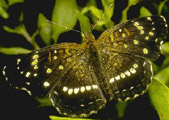Native Plants
Search for native plants by scientific name, common name or family. If you are not sure what you are looking for, try the Combination Search or our Recommended Species lists.
Dicliptera brachiata
Dicliptera brachiata (Pursh) Spreng.
Branched Foldwing, Branched Dicliptera
Acanthaceae (Acanthus Family)
Synonym(s): Diapedium brachiatum, Dicliptera brachiata var. attenuata, Dicliptera brachiata var. glandulosa, Dicliptera brachiata var. ruthii, Dicliptera glandulosa, Justicia brachiata
USDA Symbol: DIBR2
USDA Native Status: L48 (N)
Plant Characteristics
Duration: PerennialHabit: Herb
Root Type: Fibrous
Leaf Retention: Deciduous
Leaf Complexity: Simple
Leaf Shape: Ovate
Leaf Venation: Pinnate
Leaf Pubescence: Glabrous
Leaf Margin: Entire
Leaf Apex: Obtuse
Leaf Base: Rounded
Leaf Texture: Smooth
Breeding System: Flowers Bisexual
Fruit Type: Capsule
Size Notes: Up to about 30 inches tall.
Leaf: Green
Flower: Flower to 2 cm long
Fruit: Seeds brown 5-6 mm
Bloom Information
Bloom Color: White , Pink , PurpleBloom Time: Jul , Aug , Sep , Oct
Bloom Notes: Occasionally white.
Distribution
USA: AL , AR , FL , GA , IL , IN , KS , KY , LA , MO , MS , NC , OK , SC , TN , TX , VANative Habitat: Shady moist areas
Growing Conditions
Water Use: MediumLight Requirement: Part Shade
Soil Moisture: Moist
Conditions Comments: This plant is happy in a nice woodland garden with bright light where it will bloom best. Tolerates full sun, but may get sunbleached unless kept well watered and in rich soil. Reseeds prolifically and can be somewhat pesky, so consider the most appropriate location for it.
Benefit
Conspicuous Flowers: yesAttracts: Butterflies
Larval Host: Texan crescent
Butterflies and Moths of North America (BAMONA)
|
Texan Crescent (Anthanassa texana)  Larval Host |
National Wetland Indicator Status
| Region: | AGCP | AK | AW | CB | EMP | GP | HI | MW | NCNE | WMVE |
| Status: | FACW | FACW | FACW | FACW |
From the National Organizations Directory
According to the species list provided by Affiliate Organizations, this plant is on display at the following locations:Lady Bird Johnson Wildflower Center - Austin, TX
Brackenridge Field Laboratory - Austin, TX
Bibliography
Bibref 1186 - Field Guide to Moths of Eastern North America (2005) Covell, C.V., Jr.Bibref 1185 - Field Guide to Western Butterflies (Peterson Field Guides) (1999) Opler, P.A. and A.B. Wright
Search More Titles in Bibliography
Web Reference
Webref 78 - Missouriplants.com (2020) Missouri Native Plant SocietyWebref 23 - Southwest Environmental Information Network (2009) SEINet - Arizona Chapter
Additional resources
USDA: Find Dicliptera brachiata in USDA PlantsFNA: Find Dicliptera brachiata in the Flora of North America (if available)
Google: Search Google for Dicliptera brachiata
Metadata
Record Modified: 2023-02-06Research By: JSC, ADA